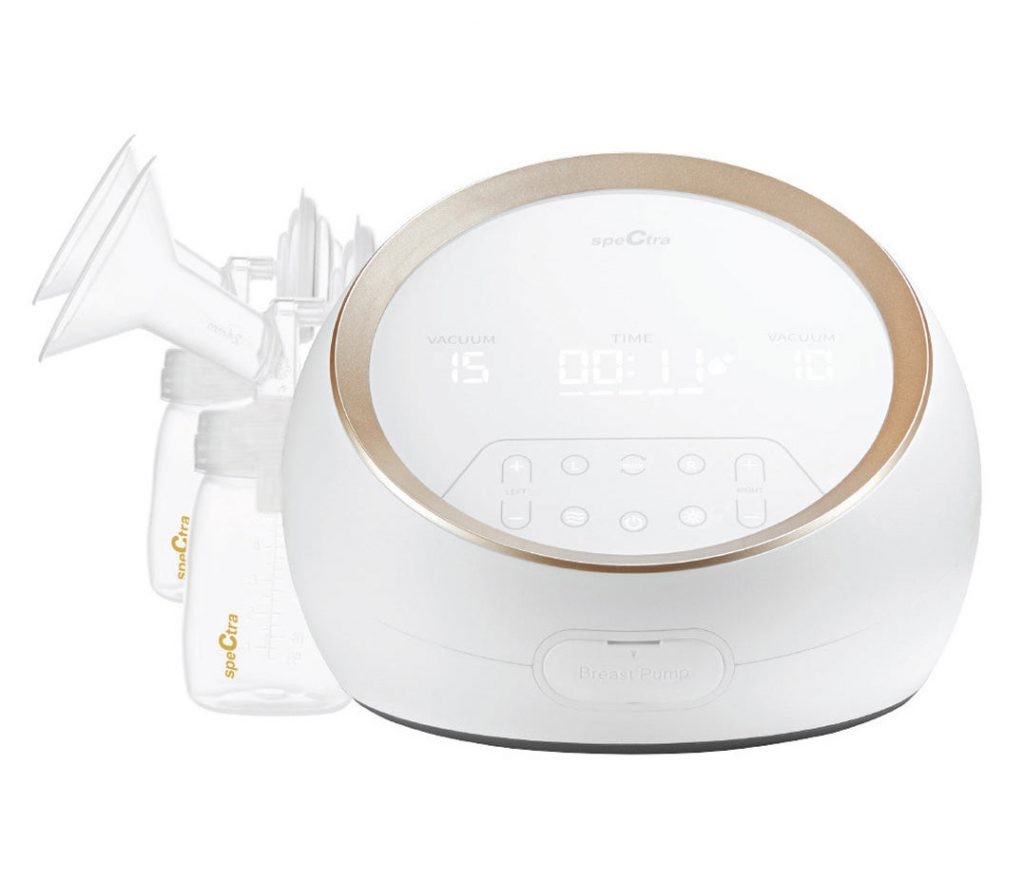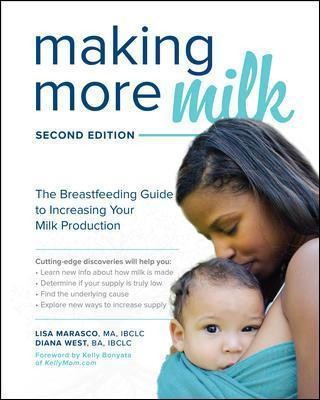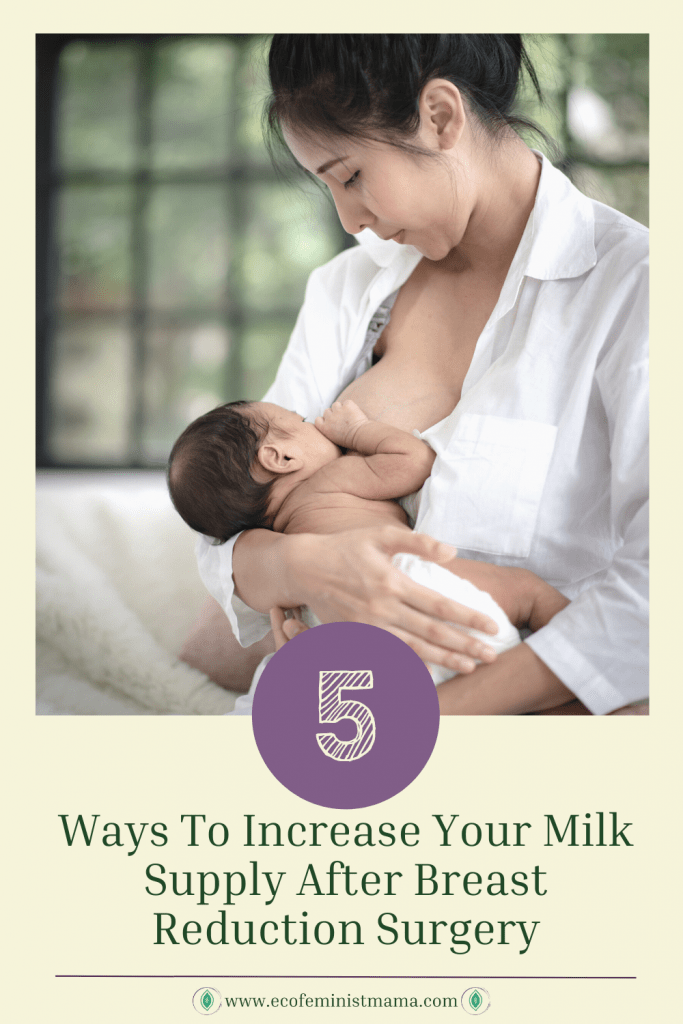Because I write a blog on natural pregnancy, birth and motherhood, people often assume I exclusively breastfed my daughter Ursula. But I had a terrible time trying to breastfeed and ended up combination-feeding breastmilk and formula. One reason my breastfeeding journey was so hard was because I’d had breast reduction surgery on my right breast. Now I’m 35 weeks pregnant with my second, I’m doing plenty of research into breastfeeding so I’m more prepared. I’ve been learning a lot and I know I’m not alone in having had this kind of surgery. So I thought I’d write a quick post about breastfeeding after breast reduction surgery for women like me.
Table of Contents
BABY! This is a reusable block, so whatever edits you make in it will apply everywhere it is used. If you want to remove this disclaimer from a post then be careful to delete the parent block (type ‘Reusable Block’ – icon is lego brick), and not to delete the group, image and/or the paragraph blocks (cos then they’ll be deleted from every instance of the reusable block).
Disclaimer: This post contains ethical affiliate links that I genuinely recommend. I may receive a small percentage of any purchases you make as a result of clicking those links. This comes at no extra cost to you and helps me to run this site. Read my full disclosure
Does breast reduction surgery affect breastfeeding?
Most types of breast reduction surgery do have a negative impact on breastfeeding. Breast reduction techniques that do not completely sever the nipple and areola are more likely to support future breastfeeding. Breasts can often repair even when the nipple and areola were completely removed during surgery, after a good recovery time. This is more likely if the surgery took place several years ago.
I had a reduction on my right breast over 25 years ago. I was a teenager when I had it to correct a breast asymmetry caused by hypoplasia in my left breast. The surgery did involve completely removing the nipple and areola. They told me I would be unlikely to be able to breastfeed at all. Not that I cared at that age, I didn’t even want children back then!
When I had Ursula in 2018, both my breasts were able to produce milk. They are now producing colostrum again in my third trimester of this pregnancy. Even if you had the most invasive form of reduction surgery, there’s still a good chance you can produce milk.
What are the chances of being able to breastfeed after reduction?
The chances of being able to breastfeed after breast reduction surgery vary from woman to woman. It depends what type of surgery you had and whether your nipple and areola were fully removed. However some research has found that up to 70% of women are able to produce some milk after reduction surgery.
Remember that breastfeeding is not “all or nothing” though. If you can lactate, even feeding your baby with a partial supply will give them all the benefits of breastfeeding. There is so much “breast is best” messaging and pressure to breastfeed from medical professionals. Topping up with formula can make you feel very guilty. But even a few drops of breast milk a day is beneficial to you baby. It’s okay to take the pressure off yourself to do it exclusively if it’s just not happening.
How can I increase my milk supply after breast reduction?
The top 5 best ways to increase milk production after breast reduction surgery are:
- Feeding early and often
- Lots of skin to skin time
- Pumping after and between feeds
- Using special milk enhancing herbs known as galactagogues
- Sleeping next to baby
Feeding early & often
The first two weeks of breastfeeding are vital for establishing a good milk supply. When you’re breastfeeding after a reduction (BFAR) it’s even more important to be on the ball.
Make sure you feed your baby as soon as possible after birth, preferably within one hour. The “golden hour” after birth is a crucial time where you should keep your baby skin to skin. Among other things, this encourages and enables baby to initiate breastfeeding. All newborns have the instinctive ability to search for and latch onto the breast for their first feed. Babies who have the chance to do this “breast crawl” are more likely to have a good latch and overall breastfeeding success.
So that you can get a good golden hour, try to avoid letting midwives or nurses taking your baby away for routine checks. Being weighed straight away is not nearly as important as your breastfeeding success.
In the coming days you should aim to feed your baby as much as possible, at least every 2-3 hours and whenever they show early hunger cues. Early hunger cues include:
- Stirring and looking more alert
- Sucking on lips or hands
- Head turning and looking for a breast
These are subtle cues that are easy to miss, but try to look out for them Mid-hunger cues include stretching, moving more and putting the hand into the mouth. Crying, turning red and becoming very agitated are the very latest hunger cues. You should avoid letting the baby get to this point. Once they’re crying you’ll need to comfort and settle them first before they can feed properly.
Lots of skin to skin time
Skin to skin contact (SSC) is where the baby is placed naked onto their mother’s bare skin, preferably the chest and tummy for maximum skin contact. It has a number of benefits including:
- Regulating the baby’s temperature
- Calming the baby
- Improved mother-baby bonding
- Regulating the baby’s heartbeat and breathing
- Stimulating the hormones needed for milk production
- Increased interest in feeding from baby
The more skin to skin time you have with your baby the more you both benefit from it. When you’re trying to establish breastfeeding and milk supply, you should aim for as much SSC as possible. If you’ve had a caesarean birth, you should still be able to do skin to skin afterwards. Ask your midwife or doctor about how to get SSC after a c-section. If your baby needs to be given special care immediately after birth, ask your care providers about kangaroo care and how they will support you in breastfeeding.
Pumping after & between feeds
Pumping to increase milk supply is based on the “supply and demand” element of normal breastfeeding. For non-BFAR mothers, the more babies feed the more milk breasts produce. That’s not always the case for mothers who have had breast reduction surgery. The injured milk ducts and nerves in our breasts don’t always respond to pumping. However many BFAR mothers successfully increase their milk supply by pumping after feeding their baby.
If you would like to try using a breast pump as part of your BFAR strategy, don’t be tempted to buy one second hand to save money. Second hand breast pumps are full of lurking bacteria and have often been worn down with use. When your supply is vulnerable, why risk wasting time and money on a pump that isn’t up to the task?
The best type of breast pump is a hospital grade pump. These are very expensive to buy so most women rent them from their local hospital. You can ask your midwife if this is something you’re interested in.
Alternatively, Spectra do a range of top quality breast pumps that are recommended by lactation consultants and as close to a hospital grade pump as you can buy commercially.
I’ve purchased a Spectra Dual Compact Electric Breast Pump to help me increase my milk supply. It’s portable so I can pump without being plugged in – this is crucial when you’ve got a 4 year old to keep up with! Plus you can adjust the pump strength on each side, which I think is perfect for a BFAR mum. When you’ve got breasts with “additional needs”, you need to be able to respond to each one differently.
The Spectra S1 is the classic model and currently on sale for those on a tighter budget.
Using herbal galactogogues
You should remember that there is no magic pill or potion that can suddenly fix all your breastfeeding after reduction challenges. However, when they’re part of a holistic strategy some herbal remedies can help support breastfeeding. BFAR mothers should look for herbs that can stimulate the mammary glands.
Herbs reputed to have milk supply boosting qualities include:
| Herb | Other Effects/Benefits | Possible Side Effects | Cautions |
| Alfalfa | Mammary gland stimulation; contains iron, calcium, vitamins A, C, E & K | Loose stools; possible increase in sunburn sensitivity | Related to peanuts so avoid if allergic to nuts; avoid if history of lupus or if taking immuno-suppressants |
| Aniseed/Anise Seed (Note: not the same as star anise) | Milk ejection aid; stimulates oestrogen production | Allergenic for some people | Not for use in pregnancy |
| Ashwagandha Root | Relaxant; stimulates T4 thyroid hormone | None known | Not for use in pregnancy; could increase the symptoms of auto-immune diseases |
| Black Cohosh Root | Mammary gland stimulation; milk ejection aid | Possibly allergenic; can cause gastric discomfort | Not for use in pregnancy; only suitable for short-term use while breastfeeding; use in small quantities only |
| Black Seed/Black Cumin | Mammary gland stimulation | Possibly allergenic; can cause gastric discomfort | Not for use in pregnancy; avoid if bleeding disorders present |
| Blessed Thistle | Hormone balancing | Possibly allergenic; high doses can cause gastric discomfort | Not for use in pregnancy |
| Borage | Enriches milk; relaxant | Minor gastric discomfort; loose stools | Only safe in low dosages (1-2g oil capsules per day) and very short term |
| Caraway Seed | Milk ejection aid; relaxant | Constipation; possible allergen; mild stomach ache | Avoid using in large dosages |
| Chasteberry | Hormone balancer; milk ejection aid; mammary gland stimulation | Rash; itching | Not for use in pregnancy; may conflict with birth control pills |
| Coriander Seed | Milk ejection aid | Potential allergen; gastric discomfort | Related to celery; only use in small amounts |
| Dandelion Leaves | Thyroid support | Skin reaction (rare) | Do not forage from areas that may have been treated with chemicals and pesticide |
| Dill Seed | Milk ejection aid; relaxant | Potential allergen; rash; itching | None known |
| Fennel Seed | Relaxant; milk ejection aid; mammary gland stimulation | Skin reaction | Related to celery; not for use in pregnancy; large amounts may be toxic |
| Fenugreek Seed | Mammary gland stimulation | Upset stomach; possible allergen, especially for asthmatics; some women report reduction in milk supply | Diabetics or those with hypoglycemia should consult their doctor before taking; not for use in pregnancy; do not use in combination with thyme; may reduce thyroid T3 hormone |
| Goat’s Rue | Mammary gland stimulation | Occasional blood-thinning | Diabetics or those with hypoglycemia should consult their doctor before taking; not for use in pregnancy |
| Hops Flower | Mammary gland stimulation; milk ejection aid | Potential skin reaction | Do not use if history of depression is present |
| Marshmallow Root | Enriches milk | Possible allergen (rare) | Consult your doctor first if you are on any other medication |
| Milk Thistle | Boosts prolactin, the milk-making hormone; protects the gallbladder and liver | Possible allergen; mild laxative at first | Not for use in pregnancy |
| Nettle | High in antioxidants and iron | Minor gastric discomfort | None known |
| Oat Straw | High in iron and magnesium | None known | Contains gluten |
| Red Clover | Mammary gland stimulation; increases thyroid hormone | Loose stools and nausea (rare) | Do not take in conjunction with aspirin, hormonal birth control or blood thinners; not for use in pregnancy; avoid fermented variations |
| Red Raspberry Leaf | Milk ejection aid | None known | May reduce milk production if used for longer than two weeks; only suitable for use in third trimester of pregnancy |
| Saw Palmetto | Mammary gland stimulation; hormone balancing | Minor gastric discomfort | Do not take if bleeding disorders are present; not for use in pregnancy |
| Shatavari | Mammary gland stimulation | Mild laxative | Not for use in pregnancy |
| Vervain/Verbena | Relaxant; thyroid support | None known | Not for use in pregnancy; do not take in conjunction with blood thinning medication or aspirin; do not take if iron deficiency/anaemia is present |
Many of these herbs come in the form of capsules or tinctures. Or you can make your own herbal tea blend using the herbs you feel best suit your needs. Alternatively there are herbal supplements using a combination of these galactogogues such as Legendairy Liquid Gold and Motherlove More Milk Special Blend.
Don’t be tempted to take every single herb as not all of them will benefit you. Meanwhile the more you take, the less able you are to tell what’s working and what isn’t. Making More Milk by La Leche League expert lactation consultants Diana West and Lisa Marasco is an excellent resource for learning more about using herbal galactogogues.
Sleeping next to baby
Sleeping next to your baby, whether they are safely sharing your bed or in a bedside crib, can help increase your milk supply. This is because it increases the frequency of night-time feeding and therefore increases supply. Mothers who sleep next to their baby are also more likely to have long-term breastfeeding success.
If the thought of more night feeds fills you with horror, don’t panic! It turns out that mothers who sleep next to baby actually get more sleep than those who don’t. You can just sit up in bed, reach over and pop baby onto your breast and slide them over when you’re done, so feeds take less time.
The Lullaby Trust has a full guide on safe co-sleeping which all parents should read. Even if you don’t think you want to co-sleep, the reality is that most parents do it some point due to convenience. You must do it safely though, so do your research just in case.
I hope you’ve found this guide to breastfeeding after breast reduction surgery helpful. Having had not only a reduction but the challenge of hypoplasia as well, I understand how difficult it can be to try and breastfeed with physical disadvantages. Just the fact that you’re researching this topic and looking for help is a step in the right direction though.
Try to get hold of the book Defining Your Own Success: Breastfeeding After Breast Reduction Surgery by Diana West. I couldn’t find an ethical seller that has it in stock as it’s a rare book. However your local library or La Leche League (LLL) group might have access to one. It’s a must-have resource to help your breastfeeding journey. Do make contact with your local LLL group anyway, as they will be a brilliant source of support for you.
Wishing you all the best in your BFAR journey. Please do get in touch to tell me your breastfeeding after breast reduction success story if you would like to share your journey with me and other BFAR mothers.






